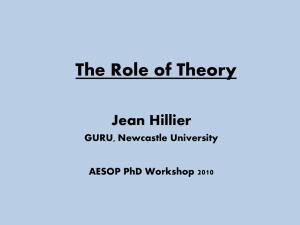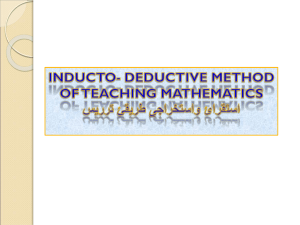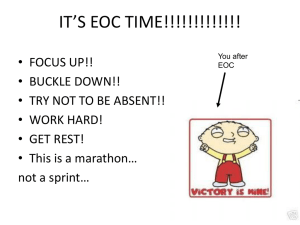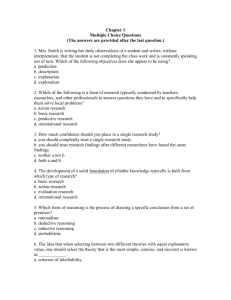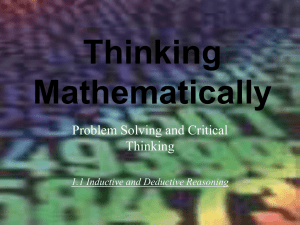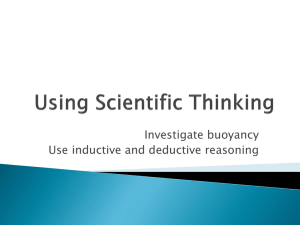Literary survey
advertisement
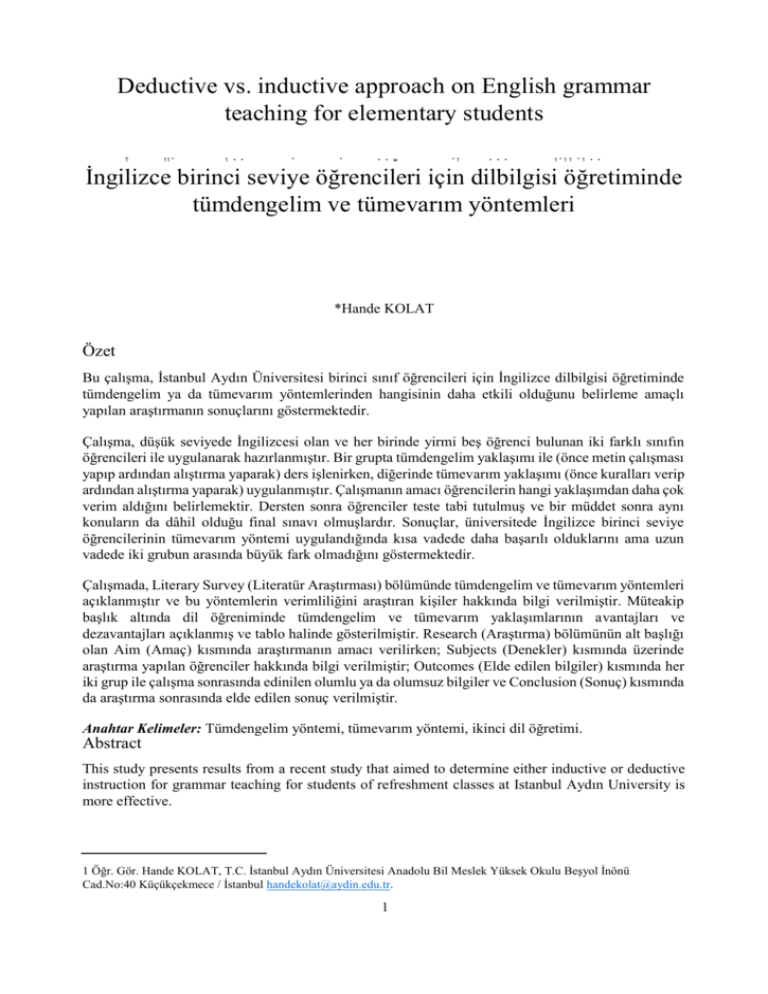
Deductive vs. inductive approach on English grammar
teaching for elementary students
T
11 *
1 • •
*
*
• • w
*1
• • •
1*11 *1 • •
İngilizce birinci seviye öğrencileri için dilbilgisi öğretiminde
tümdengelim ve tümevarım yöntemleri
*Hande KOLAT
Özet
Bu çalışma, İstanbul Aydın Üniversitesi birinci sınıf öğrencileri için İngilizce dilbilgisi öğretiminde
tümdengelim ya da tümevarım yöntemlerinden hangisinin daha etkili olduğunu belirleme amaçlı
yapılan araştırmanın sonuçlarını göstermektedir.
Çalışma, düşük seviyede İngilizcesi olan ve her birinde yirmi beş öğrenci bulunan iki farklı sınıfın
öğrencileri ile uygulanarak hazırlanmıştır. Bir grupta tümdengelim yaklaşımı ile (önce metin çalışması
yapıp ardından alıştırma yaparak) ders işlenirken, diğerinde tümevarım yaklaşımı (önce kuralları verip
ardından alıştırma yaparak) uygulanmıştır. Çalışmanın amacı öğrencilerin hangi yaklaşımdan daha çok
verim aldığını belirlemektir. Dersten sonra öğrenciler teste tabi tutulmuş ve bir müddet sonra aynı
konuların da dâhil olduğu final sınavı olmuşlardır. Sonuçlar, üniversitede İngilizce birinci seviye
öğrencilerinin tümevarım yöntemi uygulandığında kısa vadede daha başarılı olduklarını ama uzun
vadede iki grubun arasında büyük fark olmadığını göstermektedir.
Çalışmada, Literary Survey (Literatür Araştırması) bölümünde tümdengelim ve tümevarım yöntemleri
açıklanmıştır ve bu yöntemlerin verimliliğini araştıran kişiler hakkında bilgi verilmiştir. Müteakip
başlık altında dil öğreniminde tümdengelim ve tümevarım yaklaşımlarının avantajları ve
dezavantajları açıklanmış ve tablo halinde gösterilmiştir. Research (Araştırma) bölümünün alt başlığı
olan Aim (Amaç) kısmında araştırmanın amacı verilirken; Subjects (Denekler) kısmında üzerinde
araştırma yapılan öğrenciler hakkında bilgi verilmiştir; Outcomes (Elde edilen bilgiler) kısmında her
iki grup ile çalışma sonrasında edinilen olumlu ya da olumsuz bilgiler ve Conclusion (Sonuç) kısmında
da araştırma sonrasında elde edilen sonuç verilmiştir.
Anahtar Kelimeler: Tümdengelim yöntemi, tümevarım yöntemi, ikinci dil öğretimi.
Abstract
This study presents results from a recent study that aimed to determine either inductive or deductive
instruction for grammar teaching for students of refreshment classes at Istanbul Aydın University is
more effective.
1 Öğr. Gör. Hande KOLAT, T.C. İstanbul Aydın Üniversitesi Anadolu Bil Meslek Yüksek Okulu Beşyol İnönü
Cad.No:40 Küçükçekmece / İstanbul handekolat@aydin.edu.tr.
1
The study was carried out at Istanbul Aydın University with two different classes, both of which
have
H. Kolat
native speakers of twenty-five Turkish students with elementary proficiency in English, and both of
which are in refreshment classes with no English background and some of whom are false beginners.
One group is instructed by inductive approach (giving the text first, and then introducing the relevant
rule), while the other is instructed by deductive (giving the rules first and then practicing on it). The
purpose was to find out from which one of the two approaches students would benefit more. After the
class, students are given tests and after a period of time they had their final exams. The results indicate
that the class instructed by deductive approach is more successful than the other. The results of this
study support using deductive instruction to teach grammar in the elementary level university foreign
language classes. The research testing materials are appended.
Keywords: Inductive approach, deductive approach, second language
teaching. Literary survey
The inductive approach is a more modern style of teaching where the new grammatical structures or
rules are presented to the students in a real language context (Goner, Phillips, and Walters 135). The
students learn the use of the structure through practice of the language in context, and later realize the
rules from the practical examples. For example, if the structure to be presented is the comparative form,
the teacher would begin the lesson by drawing a figure on the board and saying, "This is Jim. He is
tall." Then, the teacher would draw another taller figure next to the first saying, "This is Bill. He is
taller than Jim." The teacher would then provide many examples using students and items from the
classroom, famous people, or anything within the normal daily life of the students, to create an
understanding of the use of the structure. The students repeat after the teacher, after each of the different
examples, and eventually practice the structures meaningfully in groups or pairs. (Goner, Phillips, and
Walters 135-136) With this approach, the teacher's role is to provide meaningful contexts to encourage
demonstration of the rule, while the students evolve the rules from the examples of its use and
continued practice (Rivers and Temperley 110).
In a language classroom while instructing with inductive approach, the teacher at first gives a text or
context and then introduces the subject implicitly without mentioning the rules. After the learners do
exercises about the text they are given the rules. For example, the teacher gives a text and then asks
the learners to identify verbs and then wants them to group the verbs according to different usage of
verb forms in simple present tense, such as play and plays. Then the learners are asked to identify how
these verbs are used. The teacher monitors and guides. Group of learners then work with one category
each to analyse structure, meaning and use, and finally present their findings to the class.
The deductive approach is a more traditional style of teaching in that the grammatical structures or
rules are dictated to the students first (Rivers and Temperley, 1978). Thus, the students learn the rule
and apply it only after they have been introduced to the rule. For example, if the structure to be
presented is present perfect, the teacher would begin the lesson by saying, "Today we are going to
learn how to use the present perfect structure." Then, the rules of the present perfect structure would
be outlined and the students would complete exercises, in a number of ways, to practice using the
structure (Goner, Phillips, and Walters, 1995). In this approach, the teacher is the centre of the class
and is responsible for all of the presentation and explanation of the new material.
In a language classroom, teaching by an inductive instruction means that students are provided with
texts and examples first. The role of the teacher is to provide the language in order to help students
find the rules, to guide them in discovery and then provide more opportunities to practice. The
inductive approach is more likely to be called as modern way of teaching. Because it provides students
2
to discover, not dictate, it uses authentic material and it is a student-centred teaching and the focus
is
H. Kolat
on usage not on the rules.
On the other hand, the deductive approach in a language classroom means that the teacher gives the
rules beforehand and then gives opportunities to the students to apply them. The teacher presents the
rules and then students are given exercises. The deductive approach is more traditional than inductive
approach because it is teacher centred and it focuses initially on rules and then focuses on use.
Therefore, input language is not authentic; it is adjusted to the learners.
Advantages and disadvantages of inductive and deductive approaches in language
teaching
Advantages and disadvantages of inductive and deductive approaches are given in Table 1.
INDUCTIVE APPROACH
DEDUCTIVE APPROACH
The focus is on the learners and the use. The use The focus is on the teacher. The rules are over the
of language is over rules.
use.
3
Learner autonomy is encouraged since learners
Students are passive. They are just listeners.H. Kolat
can find out rules themselves, which is a
significant skill. Students are active.
(more) Effective for young learners at low levels
Complex rules and terminology are introduced at
(more) Effective for adults
Goes from easy to difficult
first
The rules are introduced after using them, so the The rules are introduced first and then students use
students discover the rules themselves.
Learner-centred
them.
Teacher-centred
This instruction encourages more communication This instruction makes students more passive.
Something new and radical
Old and not something different from previous
learning experiences
The learners may make incorrect assumptions for Teacher can control the level of input language, it's
forming rules
Requires more time
more controllable
More efficient use of a time
Better with syllabus structures
Table- 1: Advantages and disadvantages of inductive and deductive approaches
Both of the approaches have advantages for learning and can meet needs of different kinds of learners
and also disadvantages to some extent. The inductive approach may be more attractive since it is
learner-centred and encourages learner autonomy. However, it may be disadvantageous when it comes
to use of time, as it may be time-consuming, and also it might not be appropriate for all ages.
Deductive approach may be more controllable and it goes from easy to difficult, but it might discourage
students to discover and think owing to the fact that it is teacher centred.
Many studies have been carried out for inductive and deductive approaches, and many researchers
such as Rosemary Erlam, Constance Shaffer, Robert A. Fischer and Selinger studied on these
approaches. While some of the results support the inductive, others indicate that the deductive
instruction is a much better way to learn; finally both of them end up saying that using them both will
be helpful and more fruitful. In fact, the studies, giving different results, suggest that the instruction of
the approaches differ according to the learner's age, the way the learner learns, and language level and
also the subject that is taught; that is, the results of the studies may be different but the approaches are
applied to different kinds of learners and therefore, it is normal to get such results.
Rosemary Erlam states that research carried out up to now contrasted the effectiveness of deductive
and inductive approaches have contradictory evidences about relative effectiveness of these two
teaching techniques. She expresses that studies conducted so far have not investigated the effects of
4
these instructional methods on measures of both language production and comprehension and
also
H. Kolat
have not investigated the measures that reduce the possibility that students monitor their language
performance. Also, she says that all studies, except one, on the comparison of these focused on adult
learners (2003, pp. 244).
Rosemary Erlam's (2003) research, which compared 'the effectiveness of these two types of instruction
on measures of both comprehension and production', 'investigated the interaction between type of
instruction and the morphological and syntactical features involved in the acquisition of direct object
pronouns in French as a second language (pp.242). The results of her study indicated that the deductive
instruction group was more advantageous.
Robert A. Fischer (1979) states that many foreign language methodologists 'maintain that a deductive
approach in which the explanation of a grammatical principle precedes its application is more logical
and leads to a higher degree of certainty of grammatical knowledge, while others claim that an
inductive approach in which the student discovers the grammatical principle for himself has a greater
impact and leads to longer retention.' He expresses that 'historically the inductive approach is
associated with the audio-lingual method and the deductive approach with the cognitive method' (pp.
98-99). Those statements mean that, in contrast to the contemporary views about these two approaches,
inductive instruction is criticized as an old and lacking method like audio-lingual method, which
involves repetition and no creativity, since the teacher at fırst, gives the rules and then lets the learners
find the rules themselves.
Selinger (1975) also experimentally demonstrated the superiority of deduction over induction in terms
of long-term retention among university-age students. Also the ongoing debate that the subject to be
taught is important to determine which approach would be more effective is another issue to be
considered.
Another researcher, Constance Shaffer (1989) criticizes the deductive approach for making the learner
passive and supports that the retention of the rules or words is longer as long as the learner participates
and as long as the learner is active. In addition, Shaffer is against the association of the inductive
approach with audio-lingual approach, since inductive instruction does not aim teaching by habit
formation.
The Research
Aim
The aim of this paper is to find out which approach; implicit (inductive approach) or explicit (deductive
approach) is much more appropriate and effective for refreshment classes at Aydın University.
Inductive and deductive instructions can be used in many areas. In this paper, these two approaches
are studied in English Language teaching in general terms and in specific terms,
in the teaching of grammatical structures. These two techniques, inductive and deductive approaches
are compared, with their advantages and disadvantages and the research has been carried out with two
groups of students.
Objectives
The objectives of this research are to identify whether the inductive approach, implicit instruction, or
deductive approach, explicit instruction, is more successful for refreshment classes, having only four
hours of classes a week. This is accomplished by instructing two different groups with two different
approaches and then applying the same quiz and same final examination.
Research questions
1. How are deductive and inductive approaches applied in a language classroom?
5
2. Which method is more fruitful for students; inductive or deductive?
3. Which method provides longer retention?
H. Kolat
Research method
Here is the track for applying deductive instruction;
The teacher makes sentences while pointing out the objects in the classroom, such as 'There is a table',
'There is a door', 'There isn't a TV', and 'There are windows', 'There aren't computers' and then writes
the sentences on the board.
The teacher gives the learners, the group which is composed of twenty-five students from the
department of International Logistics, the rules of grammatical structure, 'there is, there are". The
teacher then explains the structure in detail with its positive, negative, question, singular and plural
forms, how it works and how it is made.
Learners then practice the language on given specific rules with fill in the blanks activity, where they
fill in the blanks with "to be" verb in singular, plural, negative, positive and question forms.
After doing some exercises, the teacher shows pictures on the book and makes sentences with 'some'
and 'any'; 'There are some plants, 'There aren't any curtains'. The teacher then explains the structure in
detail with its positive, negative, question, singular and plural forms, how it works and how it is made.
After that, they read a text called 'Bubble House', including the grammar structures taught, and answer
the reading comprehension questions and complete true-false exercise according to the text. The
reading text takes place in the learner's main course book New Headway English Elementary Students
Book. . After reading the text and completing the chart of the grammar part, the learners are provided
with more exercises that the main course book supports.
Here is the track for applying inductive instruction;
The teacher asks the learners, the group which is composed of twenty-fıve students from the
department of Public Relations, to read the reading passage in their course book. The learners are
introduced the text 'Bubble House' at first, and after reading the text and teaching the related vocabulary
in the text, the teacher asks students to answer the reading comprehension questions and then truefalse questions. After the exercises are completed, the teacher asks the learners to underline the phrases
'there is', 'there are', 'some' and 'any'. After that, learners are guided to identify the rules themselves, by
looking at the text through context. They identify the rules by the table given in the book to complete
'to be' parts of 'there is' and 'there are' phrases, and look at the grammar spot part of the book for 'some'
and 'any'. After reading the text and completing the chart of the grammar part, the learners are provided
with more exercises that the main course book supports.
Testing
One week after, both of the learner groups had the same quiz, which not only tested the subjects taught
one week before, but also the subjects taught since the beginning of the track. The learners were tested
by the subjects such as 'Use of Simple Present Tense', 'that-those', 'this- these', use of 'some and any'
and use of 'there is' and 'there are'. Also the learners had a final exam, including these subjects that are
taught during the research.
6
Subjects
H. Kolat
The two groups, with whom the research was carried out, are from different classes and departments.
The population of two classes is twenty-five. In one group, subjects are students of International
Logistics department; the others are students of Public Relations.
Students did not have any background information about the subject that was going to be taught
throughout research.
Outcomes
At the quiz, the group of learners instructed with deductive approach, the students of International
Logistics Department, scored higher than the learners instructed with inductive approach, students of
Public Relations department, but the results at the final exam were nearly same. Quizzes and final
exams are evaluated out of 100 points and results are given in Table 2.
Departments
Public Relations
The
students
25
International
Logistics
number
of The Method Used
QUIZ
Average Score
Inductive Method
FINAL
EXAM
72
Average Score
68
84
69
Deductive
25
Method
Table- 2: The Figurative Results of Tests
Conclusion The
research result
This study investigated the efficiency of the deductive approach, "in which the explanation of a
grammatical principle precedes its application is more logical and leads to a higher degree of certainty
of grammatical knowledge (for some methodologists)" and inductive approach "in which the student
discovers the grammatical principle for himself has a greater impact and leads to longer retention (for
other methodologists)" on teaching grammar in a language classroom (Robert A. Fischer, 1979, pp.
98).
Deductively instructed learner's being more successful at the quiz implies that for short term retention,
deductive instruction is more effective. Both of the groups' having approximately same scores at final
exam, indicates that the subjects ('there is', 'there are', 'some' and 'any') instructed, with two different
methods, during research may not be that distinguishing in order to define which one provides longer
retention or acquisition; that is, the result may be different when the subject is changed.
Both of the approaches have advantages and disadvantages; however, today inductive approach is
accepted as more successful and widely used, since it is student and communication-centred and
involves discovery of the learners. Although this widely acceptance of inductive approach, in this study
deductive is more effective. On the grounds that both of the learner groups only have four classes a
week and have limited time for language class, it is not surprising to see that the deductive approach
is more effective for them, as the deductive instruction is more time efficient than the inductive. Also
owing to the fact that the learners are university-age students, throughout the lesson they expect
something similar to their previous learning experiences.
7
In addition, this study does not propose that teachers use only a deductive approach in the classroom.
H. Kolat
It should be taken into consideration that the effectiveness of the approaches may be different, which
can be solved by teacher's flexibility by incorporating various approaches into their lesson depending
on the particular situation. In this study, deductive is over inductive but with such a subject as
conjunctions, inductive approach may be more effective.
In this paper, when the age, aim of the learner groups and the classes they have in a week (just 4 classes
a week) taken into consideration, it is normal to see that deductive instruction is more effective than
inductive. The major reasons are limited time for classes and students' past learning experience effect
the way they learn at present.
Suggestions for further researches
The results obtained from this study provide evidence in support of the effectiveness of deductive
instruction in a classroom with university-age learners. Further research is needed to find out whether
the efficiency of the approaches depends on the instructed subject, and also on the age of the instructed
group. In addition, to prove whether grammar teaching is more effective with deductive method, more
research should be carried out with different grammar subjects. The learners, subjects in this study,
should be researched in terms of their ability to learn, and also according to multiple intelligence
theory, since students should not be considered as learners, taught in just one way.
References
Erlam, Rosemary. (Summer 2003). "The Effects of Deductive and Inductive Instruction on the
Acquisition of Direct Object Pronouns in French". The Modern Language Journal. Vol. 87, No. 2: pp.
242-260. 24 January 2009 <http://www.jstor.org/stable/1193035>.
Fischer, Robert A. (March, 1979). "The Inductive-Deductive Controversy Revisited". The Modern
Language Journal. Vol. 63, No. 3 pp. 98-105. 24 January 2009 <http://www.jstor.org/stable/325777>.
Goner, Phillips, and Walters. (1995). Teaching Practice Handbook: Structures: Grammar and Function.
Heinemann.
Rivers, Wilga M., Temperley, Mary S. (1978). A Practical Guide to the Teaching of English as a
Second or Foreign Language. Oxford University Press.
Seliger, Herbert W. (1975). "Inductive Method and Deductive Method in Language Teaching: A ReExamination" IRAL. 13, pp. 1-18. <http://www.jstor.org/stable/1212897>.
Shaffer, Constance. (Winter, 1989) "A Comparison of Inductive and Deductive Approaches to
Teaching Foreign Languages". The Modern Language Journal. Vol. 73, No. 4: pp. 395-403. 24 January
2009 < http://www.jstor.org/stable/326874>.
8
ABMYO
Dergisi. 13,(2009) (99-108)
H. Kolat
9
